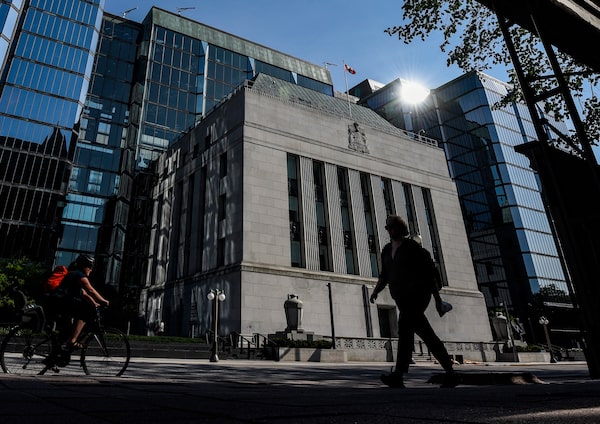
The Bank of Canada is expected to increase interest rates once more this week, capping off a tumultuous year for the central bank.Justin Tang/The Canadian Press
The Bank of Canada is expected to cap its tumultuous year with another interest-rate increase this week, although private-sector forecasters are split on how big the bank will go as it appears to be approaching a turning point for monetary policy.
Central bank Governor Tiff Macklem has been clear over the past month that he’s not done raising borrowing costs for Canadians. But he has started arguing that the bank needs to balance the risk of doing too little to fight inflation against the risk of doing too much and crashing the economy.
Financial markets are betting on a quarter-point rate hike on Wednesday, which would bring the bank’s benchmark interest rate to 4 per cent for the first time since early 2008. Bay Street economists are more divided, with some backing the market view and others arguing for another half-point move, as in October.
“The announcement feels exceptionally uncertain, a fitting end to a year that has been full of surprises,” Andrew Kelvin, Toronto Dominion Bank’s chief Canada strategist, wrote in a note to clients.
Most private-sector forecasters believe that the Bank of Canada is near the end of its historic rate-hike campaign. The question is whether Mr. Macklem and his team will deliver a final large rate hike on Wednesday, or proceed with smaller moves this week and again in January before pausing in early 2023.
Canadian economy’s third-quarter growth tops forecasts, but rising interest rates starting to bite
Markets expect the benchmark rate to reach 4.25 per cent early next year and remain at that level through the year.
The central bank has raised interest rates six times since March in an effort to tackle the highest inflation in four decades. Higher rates make it more expensive for Canadians to borrow money and service their existing debts, with the goal of curbing demand for goods and services and acting as a brake on price increases.
After a headlong dash, the bank is now in a more delicate phase of policy making. Monetary-policy changes take time to work through the economy, often up to six to eight quarters. The bank’s rate increases are hitting the housing market – where sales volumes and prices have plunged – but they’re only just starting to impact broader consumer spending. This lag opens up the risk of overtightening if the bank is not careful.
“If we do too much, we could slow the economy more than needed. And we know that has harmful consequences for people’s ability to service their debts, for their jobs and for their businesses,” Mr. Macklem told the parliamentary finance committee two weeks ago in his last appearance before the rate decision. The bank is already predicting near-zero growth for the next three quarters, putting the Canadian economy right on the edge of recession.
The debate among analysts about how big the central bank will go this week is complicated by ambiguous data.
Inflation is trending down. The consumer price index grew at an annual rate of 6.9 per cent in October, down from a peak of 8.1 per cent in June. Quarterly comparisons show inflation slowing even more quickly. But inflation is also broadening out, with a growing number of goods and services experiencing oversized price increases.
Employment and GDP data, published last week, likewise sent a mixed signal. The rate of unemployment fell slightly in November, while the Canadian economy grew nearly twice as fast in the third quarter as the Bank of Canada was anticipating. That said, there are plenty of signs that key parts of the economy are starting to sputter.
Residential-housing investment in Q3 was down 15.4 per cent on an annualized basis. Household spending declined 0.3 per cent in the quarter, the first drop since the second quarter of 2021, with a notable decline in spending on durable goods such as cars and furniture.
“For Canadians who own businesses or work in these sectors, this is awful news. But for the Bank of Canada, this is a win. It means that its past rate hikes are working exactly as intended,” Royce Mendes, head of macro strategy at Desjardins, wrote in a note to clients.
Part of the uncertainty about the coming rate decision is tied to central-bank communication. The Bank of Canada surprised markets in October by announcing a 50-basis-point hike rather than a widely anticipated 75-basis-point move. Ahead of that decision, Mr. Macklem had focused heavily on the risks of doing too little to fight inflation, but shifted to a more dovish narrative on the rate-decision day.
The bank’s messaging ahead of this week’s decision has been more balanced. Mr. Macklem and his colleagues have continued to warn that the economy is overheating and the labour market is too tight. But they’ve also started focusing on how rate increases are squeezing Canadians.
Senior deputy governor Carolyn Rogers used a speech last month to highlight the impact of higher rates on homeowners with variable-rate mortgages. Bank of Canada research suggests that around half of all variable-rate-mortgage holders with fixed monthly payments have already hit a “trigger rate,” forcing their payments to rise. That proportion is expected to increase to 65 per cent in the coming months.
“The bottom line is that mortgage costs for some Canadians have already increased, and they will likely increase for others in time, making homeownership more expensive,” Ms. Rogers said.
 Mark Rendell
Mark Rendell